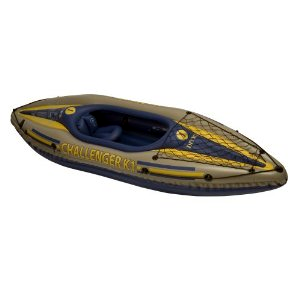 Kayaks have a lot to offer water enthusiasts when it comes to fun and maneuverability. From red to blue to yellow, kayaks are sold in a variety of colors and styles. What kind of paddling do you have in mind?
Kayaks have a lot to offer water enthusiasts when it comes to fun and maneuverability. From red to blue to yellow, kayaks are sold in a variety of colors and styles. What kind of paddling do you have in mind?Neither save a little more money and get at least a 12 foot and try out the tracking. Neither of these you have named track very well at all, and if you are going out with friends who have kayaks but longer ones you will always be lagging behind and it will not be enjoyable. 10' boats do not go very straight. Also you will outgrow these in a year or two then as your skill grows you will need a new kayak which will get expensive. A 12-13 foot is probably the best length for all around either camping or day trips. You can as well take those on larger bodies of water. If you buy a 10' thinking you will save money you will regret it.
Kayaking is an easy sport that almost anyone can master. You only need the basic equipment and knowledge of the techniques of maneuvering the craft. Safety is an important consideration in kayaking. Renting a craft from an outfitter is a good way to familiarize yourself with the equipment and techniques of kayaking.
Cheap kayaks can give you a lot of enjoyment. They can also stand up well to fair wear and tear.
Originally kayaks were timber framed covered with animal hide. This basic shape persisted for many years with the main changes veering towards a more streamlined look with different types of material being used to stretch over the wooden or aluminium frame.
Gradually though, more innovative designs crept in and with the growth of technology spurred by the introduction of synthetic material, a much broader spectrum of possibilities suddenly opened up for kayak manufacturers.
Why are some kayaks cheaper than others today? The answer is that price is almost consistently related to the material from which they are made.
The materials used to make most modern kayaks fall broadly into those constructed from:
PVC (polyvinyl chloride). It is cheap, durable and easy to work with. It came onto the market in 1926 after Mr. B.F. Goodwin, a physician and industrialist who began a tire and rubber manufacturing company worked with a Mr. W. Semon, a well known American inventor. Together they found a way to 'bend' rigid PVC. This was done by combining it with different additives. PVC can be economically rotomoulded. (Rotomoulding works a little like those fairground rides where you are whizzed around in a rotating drum, starting at the bottom you find yourself rising up and sticking to the sides - only when the kayak is made, the rotomould is heated first).
Polymer is a material which is made from either natural or synthetic substances. (Rubber is a natural polymer) A synthetic example is polyethylene, a mix of ethylene - from sulphuric acid and alcohol, and monomer - a glucose derivate. These are all more commonly known as plastics.
Fibreglass (Extruded fibres of glass) as the name suggests, began to be used commercially from 1936. Often today, the method would involve layers of cloth fibres which would be strengthened by saturating them with plastic resins - called composite material. These boats are lighter than the plastic varieties.
Nylon fabrics around 1000 denier (consider that ladies sheer stockings are around 8 denier).
Hypalon (chlorosulfonated polyethylene) - a common name for all kinds of synthetic rubber, noted for its resistance to chemicals, temperature extremes and ultraviolet light.
Kevlor (a registered trademark) is a light, strong synthetic fibre made from aramids which themselves are heat resistant synthetic fibres. Bullet proof vests are made from this type of material. It is often quoted that Kevlor is "5 times stronger than steel on an equal weight basis". Synthetic fibres have their origins in the chemical industry. Most of them are a by-product of the process which changes crude oil into gasoline and other related products.
The outcome of all this is that cheap kayaks today are made from PVC and its derivatives.
Consider this. The Sevylor Tahiti Classic kayak has been down the Amazon River, which has class V rapids, twice. That is a distance of more than 6186 miles. The kayak is made from PVC which has been modified to make it suitable for the rough and tough of kayak paddling. This journey is a first class achievement for the humble PVC.
Sevylor, Sea Eagle, Advanced Elements and Intex all make kayaks under $200. All of them are inflatables and most of them use PVC or related material.
For more on Cheap Kayaks visit our store here.





0 comments:
Post a Comment